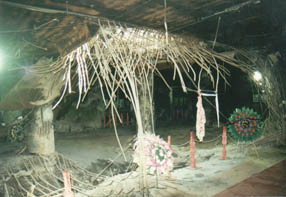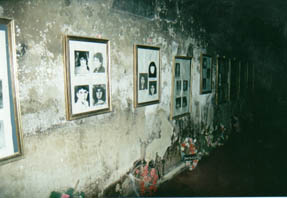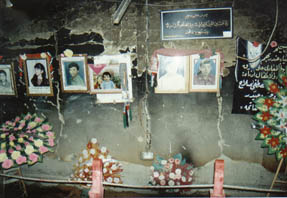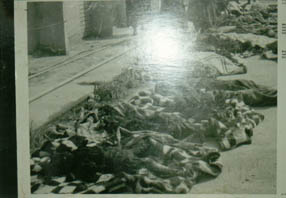Click here to return to Newsbytes
A Visit to a WMD Site in Baghdad
================================
No matter how tough you are, if you have one tenth of a heart and one percent
of a conscience, you will be shaken by the experience of visiting Al Amiriya
Bomb Shelter in Baghdad.
Yes, I just returned from there.
At 4:30 AM on February 13, 1991, an especially made American 'smart' bomb
ripped through five layers of concrete and steel into Al Amiriya Shelter to
take the lives of 480 civilians, most of whom were women, children and elderly..
 Another phosphor bomb hit the ventilation system to turn the air inside into
a brew of smoke, heat, and poisonous fumes.
The Shelter is made up of two stories. Those in the upper level were burnt
up and torn asunder. Those in the lower level died from the power of the
explosion. Their brains just blew up and they went in a frenzy of internal
hemorrhage. The photos of their remains show no mutilation, just bleeding
through the nose, ears, and sometimes the eyes. Nobody made it alive from the
shelter, except for fourteen people sleeping at the entrance who were hurled
by the power of the explosion itself away from the shelter. These are the
lucky ones. They just got away with severe injuries. The rest, well they
just perished in the hellish soup that was stirred up by the two bombs. I was
told by the guide that the power of the explosion was so great, human organs
went out of the same hole through which the bomb went in.
Another phosphor bomb hit the ventilation system to turn the air inside into
a brew of smoke, heat, and poisonous fumes.
The Shelter is made up of two stories. Those in the upper level were burnt
up and torn asunder. Those in the lower level died from the power of the
explosion. Their brains just blew up and they went in a frenzy of internal
hemorrhage. The photos of their remains show no mutilation, just bleeding
through the nose, ears, and sometimes the eyes. Nobody made it alive from the
shelter, except for fourteen people sleeping at the entrance who were hurled
by the power of the explosion itself away from the shelter. These are the
lucky ones. They just got away with severe injuries. The rest, well they
just perished in the hellish soup that was stirred up by the two bombs. I was
told by the guide that the power of the explosion was so great, human organs
went out of the same hole through which the bomb went in.
 The Iraqis have kept the inside of the shelter largely unchanged, except for a
cordoned off area in the middle, around the place the main bomb fell. Bent
steel and charred walls still testify to the terrorism of the New World Order.
Over the walls you will find lined up rows of photos for the victims of the
explosion. Old women, young women, teenagers, children, and older people
stare at you from amongst the charred walls. On another wall, another row
of photos for families peaks at you; one frame for each family that perished
in Al Amiriya Bomb Shelter. Amongst these frames I noticed one frame for a
Syrian family, then another for an Egyptian family, then another for a
Jordanian family, then another for a Palestinian family, who must have thought
that they were going to be safe from American bombs at Al Amiriya Bomb Shelter.
They were wrong. There is no place on this planet where civilians can be safe
from American bombs.
The Iraqis have kept the inside of the shelter largely unchanged, except for a
cordoned off area in the middle, around the place the main bomb fell. Bent
steel and charred walls still testify to the terrorism of the New World Order.
Over the walls you will find lined up rows of photos for the victims of the
explosion. Old women, young women, teenagers, children, and older people
stare at you from amongst the charred walls. On another wall, another row
of photos for families peaks at you; one frame for each family that perished
in Al Amiriya Bomb Shelter. Amongst these frames I noticed one frame for a
Syrian family, then another for an Egyptian family, then another for a
Jordanian family, then another for a Palestinian family, who must have thought
that they were going to be safe from American bombs at Al Amiriya Bomb Shelter.
They were wrong. There is no place on this planet where civilians can be safe
from American bombs.
 On the walls, you also find silhouettes, shadows of the dead. One woman whose
frame sticks deeper than others was evidently holding her newborn. Another
shadow is for a young woman. She died in her dreams. A third shadow right
above hers was for a severed human head, standing above all shadows like a
condemnation. They were all scraped off the same wall, but the contours
remain in shades of grey.
As you go downstairs to the lower floor, you find a distinct line on the walls
marking the level of the water that seeped from the huge water tank reservoirs
installed for the benefit of the people who sought refuge in the shelter.
Since the temperature inside reached 400 degrees Celsius, the water started
boiling, thus cooking the walls and the humans within them, on the lower floor.
It is not clear to me if these people were boiled before or after they died
however. I wish the experts looking for alleged Iraqi weapons of mass
destruction can find that out though... if they can ever spare some of their
precious time.
As you leave, you find another wall on which photos of the remains of those
excavated from Al Amiriya Bomb Shelter are lined up. In one photo there is
a blanket on a floor with human heads collected together, heads without any
eyes. In another photo you can see a body that was totally burned. The ribs
are showing through, and there are no ankles, feet, or a head. If you can
bring yourself to look some more, you will find a lot more too. But I had
had my fill by then.
On the walls, you also find silhouettes, shadows of the dead. One woman whose
frame sticks deeper than others was evidently holding her newborn. Another
shadow is for a young woman. She died in her dreams. A third shadow right
above hers was for a severed human head, standing above all shadows like a
condemnation. They were all scraped off the same wall, but the contours
remain in shades of grey.
As you go downstairs to the lower floor, you find a distinct line on the walls
marking the level of the water that seeped from the huge water tank reservoirs
installed for the benefit of the people who sought refuge in the shelter.
Since the temperature inside reached 400 degrees Celsius, the water started
boiling, thus cooking the walls and the humans within them, on the lower floor.
It is not clear to me if these people were boiled before or after they died
however. I wish the experts looking for alleged Iraqi weapons of mass
destruction can find that out though... if they can ever spare some of their
precious time.
As you leave, you find another wall on which photos of the remains of those
excavated from Al Amiriya Bomb Shelter are lined up. In one photo there is
a blanket on a floor with human heads collected together, heads without any
eyes. In another photo you can see a body that was totally burned. The ribs
are showing through, and there are no ankles, feet, or a head. If you can
bring yourself to look some more, you will find a lot more too. But I had
had my fill by then.
 No matter who you are, if you have one tenth of a heart, and one percent of
a conscience, you will find yourself shaking as you wade through Al Amiriya
Bomb Shelter, shaking with rage and anguish, or may be just shaking as you
try to hold back the tears.
As I left Al Amiriya Bomb Shelter, it was not clear to me at all how the
United States government dares to utter a word about spreading 'human rights',
'democracy', or 'freedom' in Iraq. It was less clear how the world can ever
take any of what the United States government says seriously!!
Outside the complex, there is a small kiosk for the guide. In there, visitors
can stop to write a few words in the visitors book if they wish. I wrote:
"I passed through the gate of Al Amiriya Bomb Shelter into the tragedy of Iraq
only to meet the tragedy of Palestine. Yet their faces on the walls remain,
to testify to the heroism and steadfastedness of Iraqis, and to shame to the world".
See, as you go in and out of the upper floor of Al Amiriya Bomb Shelter where
the main bomb fell, the first and the last thing you will see is a very familiar
face. No, it is not the picture of Saddam Hussein. The very first photo in
the row of photo in Al Amiriya Bomb Shelter has been placed recently it seems.
It is the photo of Muhammad Durrah, the Palestinian kid who was shot dead in
cold blood by Jewish soldiers in Gaza.
Thus, in the pit of their pain, the Iraqis did not fail to put Palestine first.
And that kind of power, in my opinion, is what the United States government
means when it says it wants to go after Iraqi weapons of mass destruction.
It is the power to wither American weapons of mass destruction, then remain
true to Palestine.
Long Live Iraq!
Later
Ibrahim Alloush, Baghdad
September 30, 2002
No matter who you are, if you have one tenth of a heart, and one percent of
a conscience, you will find yourself shaking as you wade through Al Amiriya
Bomb Shelter, shaking with rage and anguish, or may be just shaking as you
try to hold back the tears.
As I left Al Amiriya Bomb Shelter, it was not clear to me at all how the
United States government dares to utter a word about spreading 'human rights',
'democracy', or 'freedom' in Iraq. It was less clear how the world can ever
take any of what the United States government says seriously!!
Outside the complex, there is a small kiosk for the guide. In there, visitors
can stop to write a few words in the visitors book if they wish. I wrote:
"I passed through the gate of Al Amiriya Bomb Shelter into the tragedy of Iraq
only to meet the tragedy of Palestine. Yet their faces on the walls remain,
to testify to the heroism and steadfastedness of Iraqis, and to shame to the world".
See, as you go in and out of the upper floor of Al Amiriya Bomb Shelter where
the main bomb fell, the first and the last thing you will see is a very familiar
face. No, it is not the picture of Saddam Hussein. The very first photo in
the row of photo in Al Amiriya Bomb Shelter has been placed recently it seems.
It is the photo of Muhammad Durrah, the Palestinian kid who was shot dead in
cold blood by Jewish soldiers in Gaza.
Thus, in the pit of their pain, the Iraqis did not fail to put Palestine first.
And that kind of power, in my opinion, is what the United States government
means when it says it wants to go after Iraqi weapons of mass destruction.
It is the power to wither American weapons of mass destruction, then remain
true to Palestine.
Long Live Iraq!
Later
Ibrahim Alloush, Baghdad
September 30, 2002
Another phosphor bomb hit the ventilation system to turn the air inside into a brew of smoke, heat, and poisonous fumes. The Shelter is made up of two stories. Those in the upper level were burnt up and torn asunder. Those in the lower level died from the power of the explosion. Their brains just blew up and they went in a frenzy of internal hemorrhage. The photos of their remains show no mutilation, just bleeding through the nose, ears, and sometimes the eyes. Nobody made it alive from the shelter, except for fourteen people sleeping at the entrance who were hurled by the power of the explosion itself away from the shelter. These are the lucky ones. They just got away with severe injuries. The rest, well they just perished in the hellish soup that was stirred up by the two bombs. I was told by the guide that the power of the explosion was so great, human organs went out of the same hole through which the bomb went in.
The Iraqis have kept the inside of the shelter largely unchanged, except for a cordoned off area in the middle, around the place the main bomb fell. Bent steel and charred walls still testify to the terrorism of the New World Order. Over the walls you will find lined up rows of photos for the victims of the explosion. Old women, young women, teenagers, children, and older people stare at you from amongst the charred walls. On another wall, another row of photos for families peaks at you; one frame for each family that perished in Al Amiriya Bomb Shelter. Amongst these frames I noticed one frame for a Syrian family, then another for an Egyptian family, then another for a Jordanian family, then another for a Palestinian family, who must have thought that they were going to be safe from American bombs at Al Amiriya Bomb Shelter. They were wrong. There is no place on this planet where civilians can be safe from American bombs.
On the walls, you also find silhouettes, shadows of the dead. One woman whose frame sticks deeper than others was evidently holding her newborn. Another shadow is for a young woman. She died in her dreams. A third shadow right above hers was for a severed human head, standing above all shadows like a condemnation. They were all scraped off the same wall, but the contours remain in shades of grey. As you go downstairs to the lower floor, you find a distinct line on the walls marking the level of the water that seeped from the huge water tank reservoirs installed for the benefit of the people who sought refuge in the shelter. Since the temperature inside reached 400 degrees Celsius, the water started boiling, thus cooking the walls and the humans within them, on the lower floor. It is not clear to me if these people were boiled before or after they died however. I wish the experts looking for alleged Iraqi weapons of mass destruction can find that out though... if they can ever spare some of their precious time. As you leave, you find another wall on which photos of the remains of those excavated from Al Amiriya Bomb Shelter are lined up. In one photo there is a blanket on a floor with human heads collected together, heads without any eyes. In another photo you can see a body that was totally burned. The ribs are showing through, and there are no ankles, feet, or a head. If you can bring yourself to look some more, you will find a lot more too. But I had had my fill by then.
No matter who you are, if you have one tenth of a heart, and one percent of a conscience, you will find yourself shaking as you wade through Al Amiriya Bomb Shelter, shaking with rage and anguish, or may be just shaking as you try to hold back the tears. As I left Al Amiriya Bomb Shelter, it was not clear to me at all how the United States government dares to utter a word about spreading 'human rights', 'democracy', or 'freedom' in Iraq. It was less clear how the world can ever take any of what the United States government says seriously!! Outside the complex, there is a small kiosk for the guide. In there, visitors can stop to write a few words in the visitors book if they wish. I wrote: "I passed through the gate of Al Amiriya Bomb Shelter into the tragedy of Iraq only to meet the tragedy of Palestine. Yet their faces on the walls remain, to testify to the heroism and steadfastedness of Iraqis, and to shame to the world". See, as you go in and out of the upper floor of Al Amiriya Bomb Shelter where the main bomb fell, the first and the last thing you will see is a very familiar face. No, it is not the picture of Saddam Hussein. The very first photo in the row of photo in Al Amiriya Bomb Shelter has been placed recently it seems. It is the photo of Muhammad Durrah, the Palestinian kid who was shot dead in cold blood by Jewish soldiers in Gaza. Thus, in the pit of their pain, the Iraqis did not fail to put Palestine first. And that kind of power, in my opinion, is what the United States government means when it says it wants to go after Iraqi weapons of mass destruction. It is the power to wither American weapons of mass destruction, then remain true to Palestine. Long Live Iraq! Later Ibrahim Alloush, Baghdad September 30, 2002